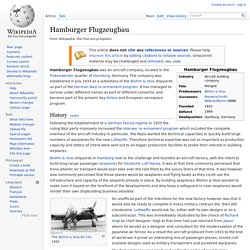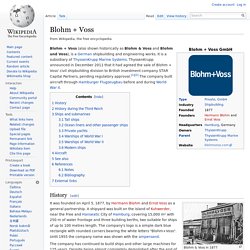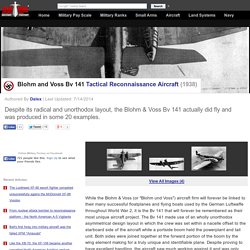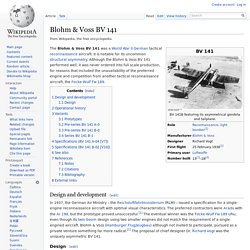

Blohm & Voss operated Hamburger Flugzeugbau aircraft company. Hamburger Flugzeugbau. Hamburger Flugzeugbau was an aircraft company, located in the Finkenwerder quarter of Hamburg, Germany.

The company was established in July 1933 as a subsidiary of the Blohm & Voss shipyards as part of the German Nazi re-armament program. It has managed to survive under different names as part of different consortia, and became part of the present day Airbus and European aerospace program. History[edit] Following the establishment of a German fascist regime in 1933 the ruling Nazi party massively increased the interwar re-armament program which included the complete overhaul of the aircraft industry.
In particular, the Nazis wanted the technical capacities to quickly build large numbers of warplanes for the new Luftwaffe. Blohm & Voss shipyards in Hamburg rose to the challenge and founded an aircraft factory, with the intent to build long-range passenger seaplanes for Deutsche Luft Hansa. Blohm + Voss. Blohm + Voss (also shown historically as Blohm & Voss and Blohm und Voss), is a German shipbuilding and engineering works.

It is a subsidiary of ThyssenKrupp Marine Systems. ThyssenKrupp announced in December 2011 that it had agreed the sale of Blohm + Voss' civil shipbuilding division to British investment company STAR Capital Partners, pending regulatory approval.[1][2] The company built aircraft through Hamburger Flugzeugbau before and during World War II. History[edit] The company has continued to build ships and other large machines for 125 years. Despite being almost completely demolished after the end of World War II, it now builds warships both for the German Navy and for export (see MEKO), as well as oil drilling equipment and ships for numerous commercial customers. The company is, along with Howaldtswerke at Kiel and Nordseewerke at Emden, a subsidiary of ThyssenKrupp Marine Systems. Blohm & Voss BV 141. Every decade in the history of military aviation has seen its share of the unconventional in aircraft design; warplanes that, in concept or configuration, markedly deviated from what was considered to be orthodox at the time of their debut.

Few more unorthodox aircraft appeared in the thirties than Dr. -Ing. Richard Vogt's asymmetrical BV 141 short-range reconnaissance and army co-operation machine which represented a highly novel approach to the problem of endowing a single-engined aircraft with outstanding all-round vision. Early in 1937, the Reichsluftfahrtministerium (RLM) issued to Arado and Focke-Wulf a specification which called for a short- range reconnaissance aircraft capable of fulfilling the light bomber, low-level attack and smokescreen-laying roles in an emergency. Blohm and Voss Bv 141 - Tactical Reconnaissance Aircraft. While the Blohm & Voss (or "Blohm und Voss") aircraft firm will forever be linked to their many successful floatplanes and flying boats used by the German Luftwaffe throughout World War 2, it is the Bv 141 that will forever be remembered as their most unique aircraft project.

The Bv 141 made use of an wholly unorthodox asymmetrical design layout in which the crew was set within a nacelle offset to the starboard side of the aircraft while a portside boom held the powerplant and tail unit. Both sides were joined together at the forward portion of the boom by the wing element making for a truly unique and identifiable plane. Blohm & Voss BV 141. The Blohm & Voss BV 141 was a World War II German tactical reconnaissance aircraft.

It is notable for its uncommon structural asymmetry. Although the Blohm & Voss BV 141 performed well, it was never ordered into full scale production, for reasons that included the unavailability of the preferred engine and competition from another tactical reconnaissance aircraft, the Focke-Wulf Fw 189. Design and development[edit] Design[edit] The tailplane was symmetrical at first, but in the 141B it became asymmetrical – starboard tailplane virtually removed – to improve the rear gunner's field of view and fire.[1] Operational history[edit] Three prototypes and an evaluation batch of five BV 141As were produced, backed personally by Ernst Udet, but the RLM decided on 4 April 1940 that they were underpowered, although it was also noted they otherwise exceeded the requirements.
Vogt came up with several other asymmetric designs, including the piston-jet P.194.01, but none of those were actually built.[1]
German Luftwaffe (1935-1946)